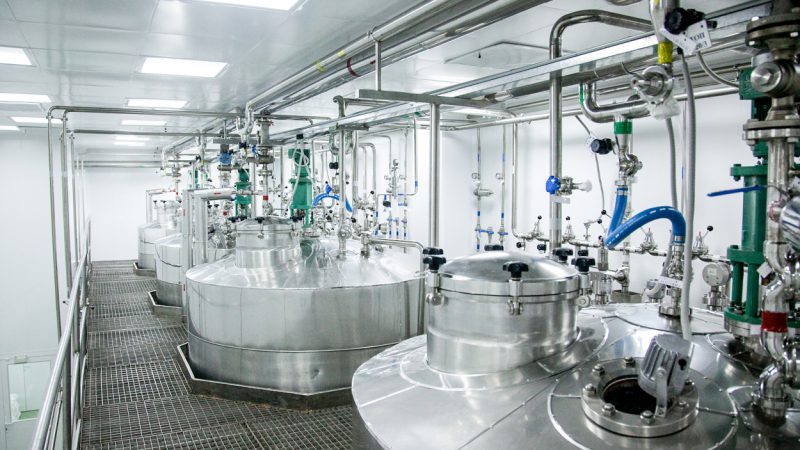Overview of PHA production
In today’s society, there is an increased attention and demand for sustainable plastics like PHA. More and more studies show the interest of producing these biopolymers in biorefineries from renewable raw materials, using mixed culture and a well-designed extraction process. The choice of carbon source, bacterial strain(s) and extraction solvent(s) are crucial to produce high quality PHA whose thermal and mechanical properties can compete with those of traditional oil-based plastics. PHA are linear polyesters that have been known since the 1920s. Seventy years after their discovery, PHA have begun to attract great interest in the world scientific community. To produce PHAs, one or more bacterial strains that (naturally) produce these polymers are used. These bacteria are grown in bioreactors under certain conditions that favour PHA production. These steps constitute an upstream process. Studies are underway to diversify carbon sources, improve bacterial strains, improve production conditions to increase PHA yields and/or produce a particular PHA. Upstream processes for PHA production are already well developed, even on an industrial scale but they remain expensive. After producing PHAs, we need to recover them. We have to extract the PHA from the bacteria. This step is a downstream process. The downstream processes for PHA production are often considered a bottleneck: whatever extraction technology is proposed, it is often expensive and/or has a high environmental impact.Current research activities on a downstream process for PHA production
As part of the Codobio (Continuous Downstream Processing of Biologics) project, I work on the development of a more efficient downstream process for PHA production. I use the tools of smart laboratories to make this process as modular, easy to use, economical and environmentally friendly as possible. Indeed, I work on the digitalization of this continuous process thanks to cheap, open-source and reliable microcontrollers and computers. My aim is to develop the different steps of the process and the associated control strategy. In particular, I have carried out encouraging preliminary tests to develop some unit operations using ESP32-based boards and a Raspberry Pi. The use of these tools on a laboratory scale enables real-time recording and control of important process data (temperature, volume and flow rate of solvents, etc.). This should facilitate its transposition to a pilot or industrial scale, as well as its economic, environmental, and social evaluation at all these scales. Moreover, I created a Process Analytical Technology (PAT) based on infrared spectroscopy for the real-time quantification of PHA. There are many prospects for microbiological processes for the production of PHA to be explored. New applications of PHA and their composites are expected in many fields. PHA have a great environmental potential. As exciting as they may be, all these perspectives and applications will have to be based on a serious analysis of their environmental, social and economic impact in accordance with the LCA guidelines and Green Metrics. While many LCA studies have focused on the environmental impact of PHA production as well as the economic impact – albeit to a lesser extent – an effort should be made to analyze the social impact of this production and consumption. This is all the truer in the context of Industry 5.0, whose three pillars are a human-centered approach for research scientist, producer and consumer, sustainability, and resilience (European Commission. Directorate General for Research and Innovation., 2020, 2021a, 2021b; Ronin and Dotelli, 2022). Author: Loïc Ronin, ESR14 CODOBIO, Politecnico di MilanoAcknowledgement:
Codobio project has received funding from the European Union’s Horizon 2020 research and innovation programme under the Marie Skłodowska-Curie grant agreement no. 812909 CODOBIO, as part of the Marie Skłodowska-Curie European Training Networks. For more information, please visit the Codobio website.
References:
European Commission. Directorate General for Research and Innovation. (2020) Enabling Technologies for Industry 5.0: results of a workshop with Europe’s technology leaders. LU: Publications Office. Available at: https://data.europa.eu/doi/10.2777/082634 (Accessed: 9 March 2022).
European Commission. Directorate General for Research and Innovation. (2021a) Industry 5.0, a transformative vision for Europe: governing systemic transformations towards a sustainable industry. LU: Publications Office. Available at: https://data.europa.eu/doi/10.2777/17322 (Accessed: 9 March 2022).
European Commission. Directorate General for Research and Innovation. (2021b) Industry 5.0: towards a sustainable, human centric and resilient European industry. LU: Publications Office. Available at: https://data.europa.eu/doi/10.2777/308407 (Accessed: 9 March 2022).
Ronin, L. and Dotelli, G. (2022) ‘Life Cycle Assessment Overview on Polyhydroxyalkanoates’, in INNOVAZIONE E CIRCOLARITÀ Il contributo del Life Cycle Thinking nel Green Deal per la neutralità climatica. Italia: Associazione Rete Italiana LCA, pp. 358–365.
